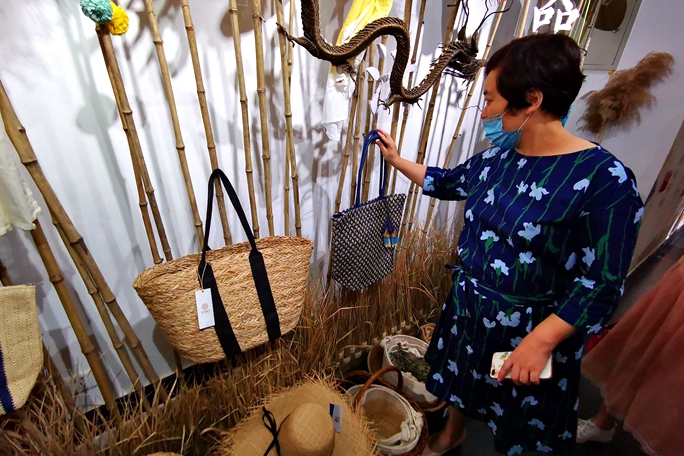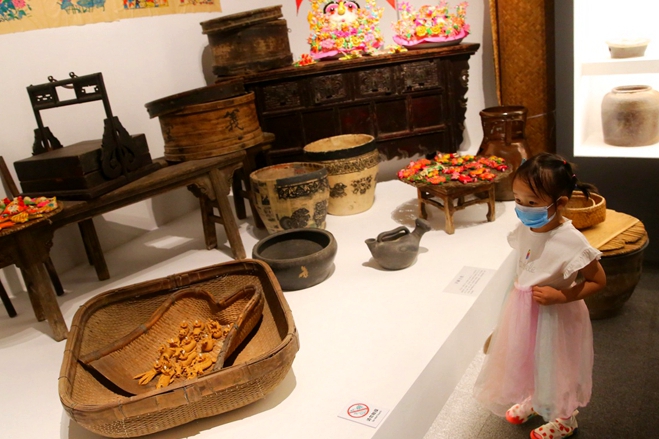Students fashion heritage artworks for modern tastes
Shandong art university program teaches how to produce new designs from traditional forms
Ren Chunhua, who has made paper-cutting works for more than 40 years, said a question that has bewildered her for three years has been answered thanks to a training program at Shandong University of Arts.
"Paper-cuttings were popular before 2012, but in the past three years, there is nearly no market for them," said the 52-year-old from Weifang, Shandong province. "I was wondering how the traditional art could survive in this modern day. The training gave me that answer."
Creativity and brand-building are crucial to paper-cutting, which was included on the UNESCO Intangible Cultural Heritage List in 2009, said Ren.
"New ideas shall be integrated into the traditional art."
The training course for paper-cutting at Shandong University of Arts, one of 18 universities selected by the Ministry of Culture in 12 provinces to teach intangible cultural heritage arts, aims to enhance the abilities of those involved in the intangible cultural heritage business, said Zhang Bing, an official responsible for the protection of intangible cultural heritage arts at the Ministry of Culture.
The courses include lessons in history, culture and brand-building strategies, artistic design and product development to help students create new products. Similar arts from overseas countries are also shown in class.
"With their comprehensive abilities enhanced, students will find ways to combine traditional skills with modern elements to create high-quality products that can be widely used today," Zhang said at the Shandong University of Arts' first paper-cutting class on July 13.
Paper-cutting and wickerwork are two art courses jointly arranged by the Shandong Provincial Department of Culture and Shandong University of Arts within a single pilot project. The courses are scheduled to end on Friday. The ages of students range from 18 to 55.
"The key to protecting intangible cultural heritages are the students inheriting these artistic skills," said Wang Fengling, director of the College of Arts Management at Shandong University of Arts.
"How can we attract more people to learn the traditional skills and become professionals? Only when the artworks have markets will young people show interest in the traditional arts," he said. "How to effectively combine traditional skills with new trends is a question students need to consider."
Ren said she is trying to "create designs that can be used on complicated luminaries" and added that she can create a paper-cutting without first sketching it out.
She believes her new works will be popular as long as she has good design ideas.
"At the training courses, those who already have good skills can learn how to create new designs to cater to modern society; and for fans, they can learn these skills from students who have mastered the skills through classes," said Wang.
Xie Yinquan, who is both a teacher and student at the wickerwork training course, is from Shandong's Linshu county, where wickerwork is listed as a city-level intangible cultural heritage. He has been doing wickerwork for 19 years.
As a student, he learns design, marketing and brand-building and as a teacher he shows young students how to make wickerwork. Xie said his works have sold to overseas markets including the United States, Australia, France and Canada.
"At the training course, I learn new ideas about overseas trends. These new ideas will help me enrich my product portfolio," said Xie.
Wang said they plan to hold the training program every year. Students who have taken the courses will then be invited to give classes to college students who major in arts design and intangible cultural heritage.
zhaoruixue@chinadaily.com.cn
(China Daily 08/05/2015 page17)

 Shandong Culture and Tourism Consumption Season
Shandong Culture and Tourism Consumption Season Culture, tourism sectors pick up in Shandong as epidemic wanes
Culture, tourism sectors pick up in Shandong as epidemic wanes

